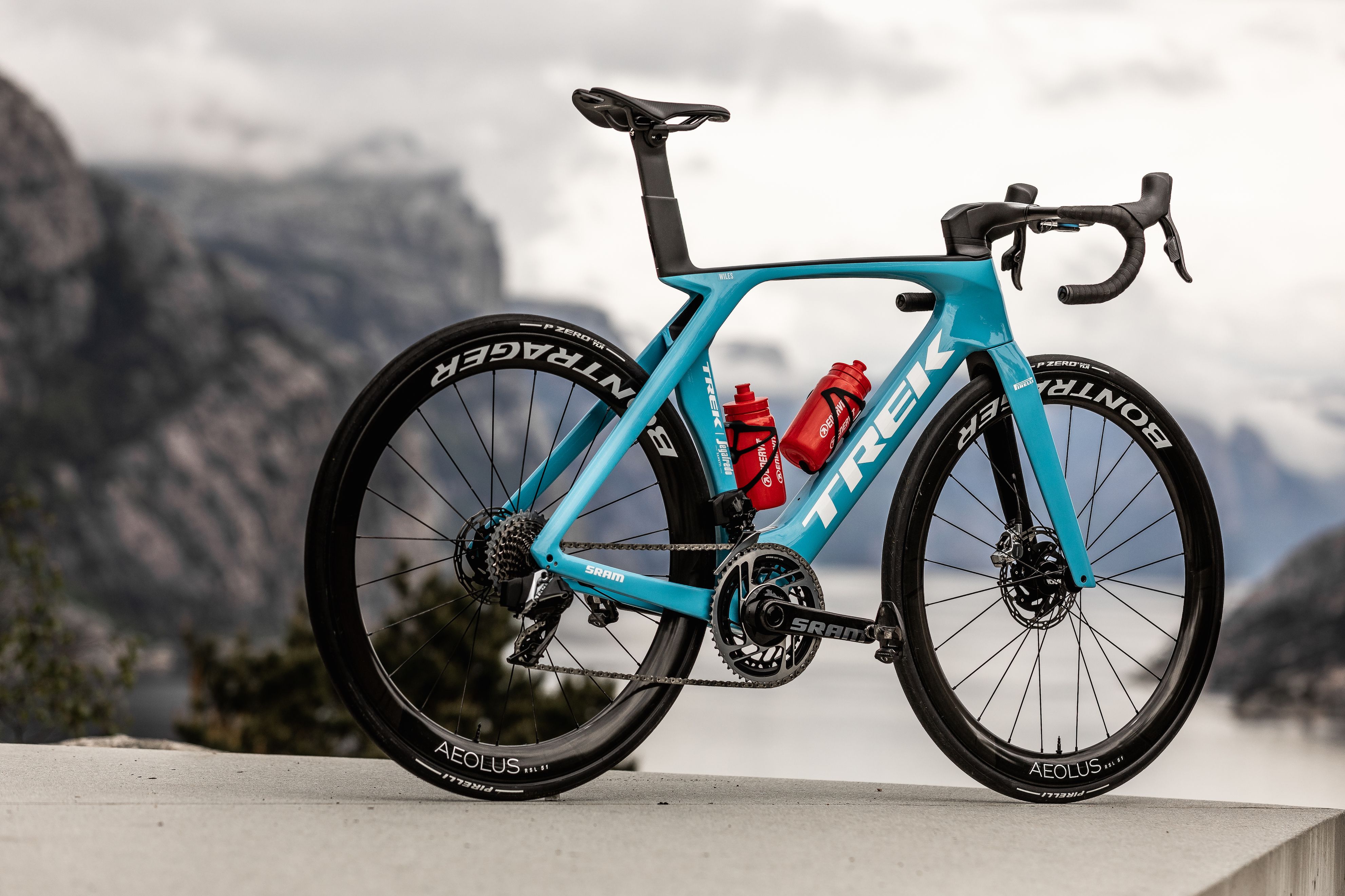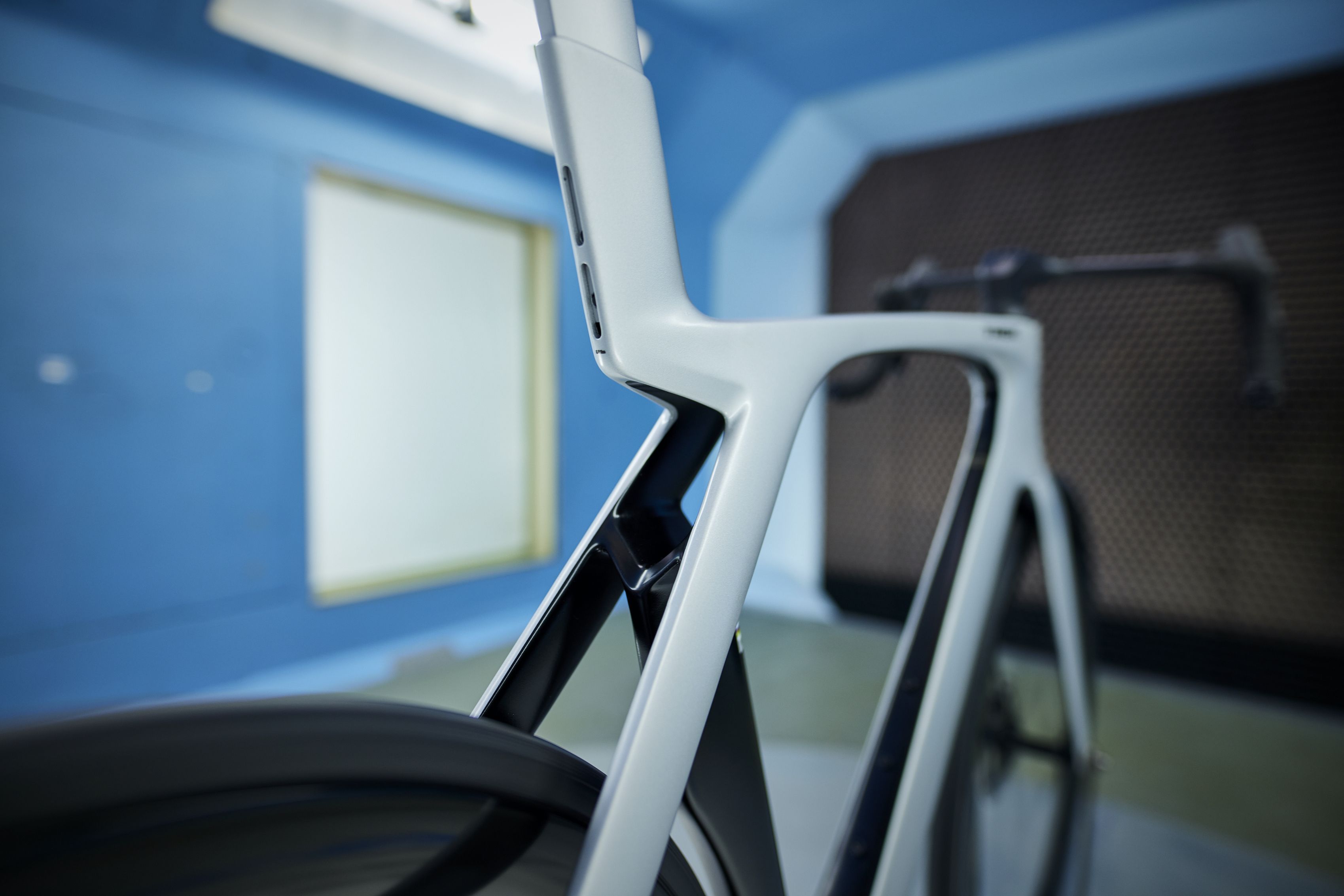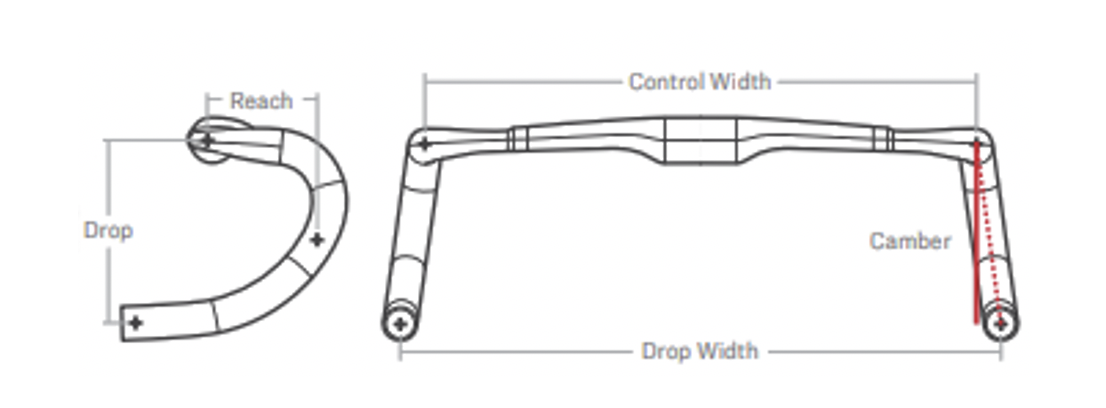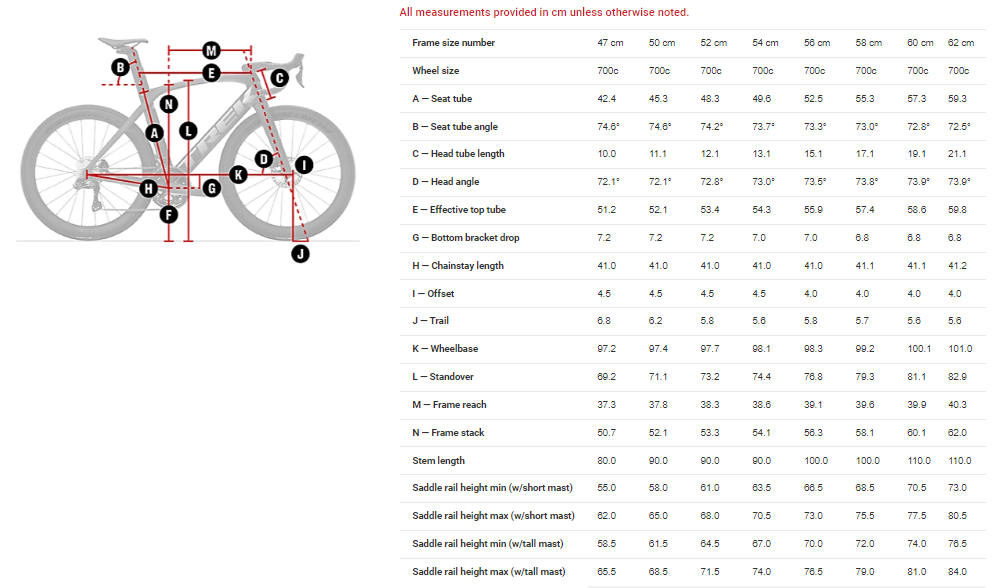Trek’s New Madone – No-Holds-Barred Racing Beauty
Trek's All-New (Seriously All-New) 7th-Generation Madone Brings Improved Aerodynamics, Reduced Weight and Radical Looks To Its Road Range.
Trek’s seventh-generation Madone SLR ticks all of the requisite boxes for top-tier road racing machines: Lighter weight, slicker aerodynamics, and more integration.

Madone SLR Background
Introduced in 2018 as a 2019 model, the 6th generation Madone was an extremely good bike and raced to countless podiums by professionals and amateurs alike. But in the competitive European peloton, it was beginning to show its age. Trek’s pro riders were looking for something faster and more aerodynamic, but they also (no surprise here) wanted it lighter. On top of that, elite riders questioned the effectiveness and need for the previous Madone SLR’s IsoSpeed damper system, while riders like you and I still needed a bike comfortable enough for everyday riding.
Trek led off its product presentation to journalists with some bold claims about the new Madone SLR. Phrases including “Fastest Madone” and “lightest Madone ever” were used by Trek representatives, as well as lots of numbers: 300 grams lighter, 60 seconds per hour faster than previous Madone, almost 10-watt savings from updated aerodynamics, 10-watt savings from changes to rider positioning. So, how did they do it?
Madone SLR Technology
Let’s start with what changed; well, lots changed, to be honest. This isn’t a case of frame engineers shaving off some grams, adopting some new parts fitment standards, and calling it a day. Bikes at the elite level go through countless hours of development, analysis, and testing—both in the wind tunnel and in the real world. The Madone is no exception to this, notably with the Trek engineering team applying intensive use of computational fluid dynamics (CFD) programs to optimise the Madone’s aerodynamic profile and rider positioning for better performance. Trek’s engineers studied the numbers and applied revised versions of its Kammtail aero tube shapes on the new Madone.
 Through the design and iteration process, the development team at Trek abandoned the sixth-generation Madone’s IsoSpeed damper system. In its place is a new cantilevered seat tube frame layout. Additionally, Trek updated the Madone’s integrated bar/stem to improve aerodynamics by changing the rider’s positioning on the hoods. This combo of radically shaped frame design and flared bars will surely draw jeers from traditionalists and cheers from anyone obsessed with speed and aero-gains—which add up to 19-watt savings at 45kph and drops 300 grams of weight.
Through the design and iteration process, the development team at Trek abandoned the sixth-generation Madone’s IsoSpeed damper system. In its place is a new cantilevered seat tube frame layout. Additionally, Trek updated the Madone’s integrated bar/stem to improve aerodynamics by changing the rider’s positioning on the hoods. This combo of radically shaped frame design and flared bars will surely draw jeers from traditionalists and cheers from anyone obsessed with speed and aero-gains—which add up to 19-watt savings at 45kph and drops 300 grams of weight.
IsoFlow
Trek calls this new seat tube-tunnel design IsoFlow. Developed through the aforementioned CFD design process, Trek claims the IsoFlow helps make the new Madone SLR lighter, simpler, stiffer, and more aerodynamic than the outgoing IsoSpeed-equipped bike.
 By integrating and tuning flex into the system via the cantilevered seat tube (rather than a separate damper system), Trek contends the new bike achieves about the same level of comfort as the previous Madone IsoSpeed in its stiffest setting. Additionally, the use of IsoFlow doesn’t have moving parts and helps to shave 150 grams off the frame weight.
By integrating and tuning flex into the system via the cantilevered seat tube (rather than a separate damper system), Trek contends the new bike achieves about the same level of comfort as the previous Madone IsoSpeed in its stiffest setting. Additionally, the use of IsoFlow doesn’t have moving parts and helps to shave 150 grams off the frame weight.
On the aerodynamics side, Trek holds that the IsoFlow system significantly reduces drag around the seat tube. The Madone’s frame shaping has been designed to accelerate air around the headtube, channeling the air into the seat tube tunnel, and then into the low-pressure zone behind the rider. All of this saves the rider 9.3 watts (of the 19 watt total) at 45 kph.
Madone SLR Integration
The balance of the remaining 9.7 wattage savings comes from changes to rider positioning. Trek’s design team (again, through the use of CFD programs and wind tunnel testing) found they could save watts by making changes to the rider position on the Madone. Since road riders spend a lot of time riding on the brake hoods, the cockpit was designed for added efficiency in that position.
 The Madone SLR handlebar measures a traditional width in the drops, but the bar’s flare positions the hoods inward by 30mm. This narrower hood location puts the rider in a more aerodynamic position when riding, thus saving watts. While the traditional width drops allow for better control when descending and more power for sprints. This isn’t a totally new concept, as aftermarket brands have been doing it for a few years now.
The Madone SLR handlebar measures a traditional width in the drops, but the bar’s flare positions the hoods inward by 30mm. This narrower hood location puts the rider in a more aerodynamic position when riding, thus saving watts. While the traditional width drops allow for better control when descending and more power for sprints. This isn’t a totally new concept, as aftermarket brands have been doing it for a few years now.
For example, if you previously rode a standard drop 420mm bar, the new bar will still measure 420mm at the drops. However, the Madone’s bar has 15mm per side (15mm x 2 = 30mm) of flare—or as Trek labels it, camber. So, the width measurement at the hoods and tops (Trek calls this the control width) only comes to 390mm.
Reach on all of the bars is 80mm and drop is 124mm. Constructed from carbon fibre, the new combo saves an additional 150 grams off the Madone’s weight.
 If you aren’t into the length or width of your frame size’s stock bar/stem, Trek offers 14 different pairings of bar width and stem length to (hopefully) meet your needs. If you want to run a traditional non-flare bar (and give back those spare 9.7 watts) you can go with a combo like the Aeolus RSL bar/stem used on the Emonda platform (the two bikes share brake hose routing). Another option would be to get a different upper headset bearing cover from Trek and use a standard 1-1/8″ stem and whatever bar you choose. If you want to run lights or mount accessories to your Madone SLR’s bar will accept a range of Blendr compatible mounts.
If you aren’t into the length or width of your frame size’s stock bar/stem, Trek offers 14 different pairings of bar width and stem length to (hopefully) meet your needs. If you want to run a traditional non-flare bar (and give back those spare 9.7 watts) you can go with a combo like the Aeolus RSL bar/stem used on the Emonda platform (the two bikes share brake hose routing). Another option would be to get a different upper headset bearing cover from Trek and use a standard 1-1/8″ stem and whatever bar you choose. If you want to run lights or mount accessories to your Madone SLR’s bar will accept a range of Blendr compatible mounts.
To accommodate the new IsoFlow design, Trek engineers needed to re-engineer the Madone’s seatpost design. The seatpost wedge now has a flip-chip design for added post extension/adjustment. Posts will be available in two lengths and two offsets.
Geometry
The H1.5 geometry set used on the 6th-gen Madone carries over the new 7th-gen Madone SLR. This was originally conceived as a meeting point between the exclusively racing-focused (H1) and more relaxed (H2) geometries offered on the 5th-gen version of the frame. If it’s not broken, don’t fix it I guess.
Stem/bar combinations that come stock on each frame size are as follows:
47cm: 380mm x 80mm, 50cm & 52cm: 400mm x 90mm, 54cm: 420mm bar width x 90mm stem length, 56cm & 58cm: 420mm x 100mm, 60cm & 62cm: 440mm x 110mm

Frame Features and Standards
Now that we’ve got the fancy tech stuff out of the way, let’s get down to some of the other details we all love to pour over whenever a significant new bike comes out.
Tire clearance on the Madone SLR is tight. The bike ships with 25mm tires and fits up to 28mm in width. This isn’t a gravel bike.
For maximum compatibility options, Trek continues with the T47 bottom bracket shell on the Madone. It has threads; your mechanic will love you.
The battery for Di2 equipped models is located in the seat tube…at the bottom of the seat tube. It can be accessed via a port in the bottom bracket shell. You’ll need to remove your crank and BB to get the battery out, but that’s a pretty rare occurrence these days.
Also relating to batteries, the new Madone goes fully electric and there are no frame options to run mechanical groupsets. So, this means that only wireless (like AXS) and semi-wireless (like Di2) are compatible.
For wheels, both front and rear remain with industry standards for road bikes: 12mm x 142mm for the rear hub and 12mm x 100mm for the front.
For brakes, the attachment standard is 160mm direct mount for the fork, and 140mm direct mount on the frame. If you want to run a 160mm on the back you will need an adaptor. 160mm is the maximum rotor the frame and fork can accept.
 And finally, storage. The frame does not have any stash boxes or cargo holds built into the frame. This was done for improved aerodynamic tube shapes and weight reduction. So, it means you need to carry your tools, spare tube, and CO2 in a seat bag, your jersey pockets, or (if you’re a pro) wait for the team car to roll up with a spare wheel or bike.
And finally, storage. The frame does not have any stash boxes or cargo holds built into the frame. This was done for improved aerodynamic tube shapes and weight reduction. So, it means you need to carry your tools, spare tube, and CO2 in a seat bag, your jersey pockets, or (if you’re a pro) wait for the team car to roll up with a spare wheel or bike.
Build Kit Details, Pricing, and Claimed Weights
Pricing on complete builds goes up by about R3 500 for 2023 on each model compared to equivalent 2022 Madone SLR models. Complete bikes are available in five different colours and six different groupsets—three Shimano and three SRAM.
A limited number of bikes will be available to order at the time of launch through Trek retailers, with more bikes scheduled to arrive over the next two months. Project One offerings on the Madone SLR will come at a later date, as well as framesets.
We can argue whether it’s brands like Trek (releasing electronic-only high-end bikes) or brands like SRAM and Shimano (no longer developing high-performance mechanical road groupsets) or if consumers are just voting with their dollars. But the result is that we are witnessing the death of mechanical shifting from high-end racing bikes. And that’s a little bit sad.
Trek Madone SLR6 and SLR6 eTap
SLR6
- R130 000
- 7.77kg (56cm)
- Shimano 105 Di2, 12-speed
- 50/34T chainrings, 11-34T cassette
- Bontrager Aeolus Pro 51, carbon tubeless wheels
- Madone integrated carbon handlebar/stem
SLR6 eTap
- R140 000
- 8.04kg (56cm)
- SRAM Rival eTap AXS, 12 speed
- SRAM Rival AXS Power Meter
- 48/35T chainrings, 10-36T cassette
- Bontrager Aeolus Pro 51, carbon tubeless wheels
- Madone integrated carbon handlebar/stem
Trek Madone SLR7 and SLR7 eTap
SLR7
- R155 000
- 7.5kg (56cm)
- Shimano Ultegra Di2, 12-speed
- 52/36T chainrings, 11-30T cassette
- Bontrager Aeolus Pro 51, carbon tubeless wheels
- Madone integrated carbon handlebar/stem
SLR7 eTap
- R140 000 – R145 000
- 7.77kg (56cm)
- SRAM Force eTap AXS, 12 speed
- SRAM Force AXS Power Meter
- 48/35T chainrings, 10-33T cassette
- Bontrager Aeolus Pro 51, carbon tubeless wheels
- Madone integrated carbon handlebar/stem
Trek Madone SLR9 and SLR9 eTap
SLR9
- R210 000
- 7.09kg (54cm)
- Shimano Dura-Ace Di2, 12-speed
- 52/36T chainrings, 11-30T cassette
- Bontrager Aeolus RSL 51, carbon tubeless wheels
- Madone integrated carbon handlebar/stem
SLR9 eTap
- R210 000
- 7.36kg (56cm)
- SRAM Red eTap AXS, 12 speed
- SRAM Red AXS Power Meter
- 48/35T chainrings, 10-33T cassette
- Bontrager Aeolus RSL 51, carbon tubeless wheels
- Madone integrated carbon handlebar/stem
Madone SLR Frameset
- RTBC
- approx 1 400g (frame + fork)
- Seatposts and bar/stem not included
READ MORE ON: madone racing bikes road bikes sponsored trek bikes



